Forest animals include mammals such as the African forest elephant, okapi, sugar glider, tiger quoll, wolf, black bear, moose, tapir and many types of monkeys; birds such as the great hornbill, southern cassowary and harpy eagle, as well as many types of toucans and woodpeckers.
On this page you’ll find pictures and interesting facts on these and many other animals that live in forests…
Forests
Forests are regions that are dominated by trees. There are many different types of forests, ranging from the boreal forests, also known as taiga, of the far north, to tropical rainforests, which grow near the equator.
Some forests are dominated by deciduous trees, which shed their leaves each autumn and grow them back in spring, while the trees of other forests are evergreen, retaining their leaves all year round.
Northern forests are covered in snow for much of the year, while rainforests, which are found in both tropical and temperate regions, have at least 168 cm (66 in) of rain each year.
Forests are home to a vast number of animals and plants (it’s thought that half of the world’s species live in tropical rainforests alone).
On this page, you’ll meet forest animals from all around the world.
Scroll down to see all of the animals, or click on an animal name in the list below to see information on a particular forest animal.
Page Index
- Forest Animals From Africa
- Forest Animals From Asia
- Forest Animals From Australia
- Forest Animals From Europe
- Forest Animals From North America
- Forest Animals From South America
Forest Animals
- African Forest Elephant
- American Black Bear
- Black Howler Monkey
- Black Woodpecker
- Brown-Throated Sloth
- Clouded Leopard
- Elk
- Forest Cobra
- Giant African Millipede
- Gorilla
- Great Hornbill
- Harpy Eagle
- Keel-Billed Toucan
- Lumholtz's Tree-Kangaroo
- Mandrill
- Moose
- North American Porcupine
- Northern Goshawk
- Okapi
- Orangutan
- Pileated Woodpecker
- Powerful Owl
- Proboscis Monkey
- Queen Alexandra's Birdwing Butterfly
- Raccoon
- South American Tapir
- Southern Cassowary
- Sun Bear
- Sugar Glider
- Tiger
- Tiger Quoll
- Western Capercaillie
- Wild Boar
- Wolf
See other forest animals on Active Wild:
- Rainforest Animals List with Pictures & Facts
- Taiga Animals List with Pictures & Facts
- Jungle Animals List with Pictures & Facts
Forest Animals Of Africa
African Forest Elephant
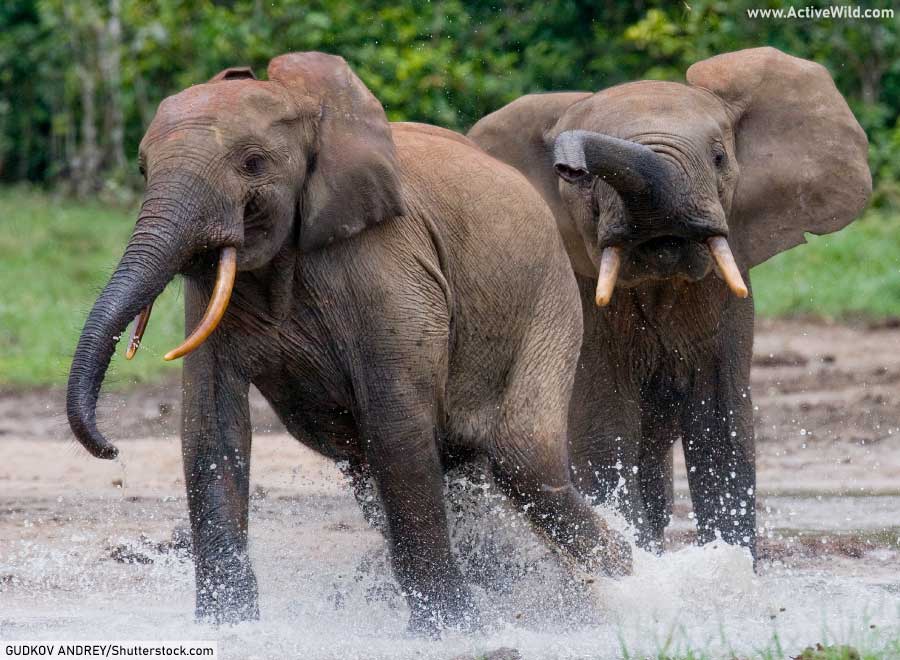
- Scientific Name: Loxodonta cyclotis
- Type Of Animal: Mammal
- Family: Elephantidae
- Where Found: Africa
- Conservation Status: Critically Endangered
The smallest of the three elephant species, the African forest elephant is found in tropical forests and other forest habitats in western and central Africa.
The largest remaining populations of African forest elephants are found in Gabon and the Republic of the Congo.
Fruit forms a major part of the forest elephant’s diet. The species also eats bark and leaves from trees.
The African forest elephant plays an important part in the ecosystem of African forests, as its helps distribute seeds (the dung of African forest elephants often contains the seeds of over 70 species of trees).
The main threat to this endangered elephant is illegal poaching. Deforestation is also a significant threat to the species, whose population is becoming ever-more fragmented as its forest habitat is lost.
You can find out more about elephants on this page: Elephant Facts
Forest Cobra

- Scientific Name: Naja melanoleuca
- Type Of Animal: Reptile
- Family: Elapidae
- Where Found: Africa
- Conservation Status: Least Concern
Although several other snakes have the word “cobra” in their names, “true” cobras belong to the genus Naja. There are 33 species of true cobra, of which the forest cobra is the largest.
The forest cobra has an average length of around 1.8 m / 5.91 ft., but individuals of lengths of up to 3.2 m / 10.50 ft. have been recorded.
The species is found mainly in the lowland forests of central and western Africa.
Like all cobras, when threatened, the forest cobra will rear up off the ground and widen its neck to make a “hood”. This makes the snake appear bigger to potential predators.
The forest cobra is venomous, and its bite can be fatal to humans.
A capable swimmer, the forest cobra is the most aquatic cobra. In some areas, fish form the bulk of its diet. The species is also a good climber and often found in trees.
You can find out more about snakes on this page: Types of Snakes
Giant African Millipede

- Scientific Name: Archispirostreptus gigas
- Type Of Animal: Myriapod
- Family: Spirostreptidae
- Where Found: Africa
- Conservation Status: Currently Unassessed
The giant African millipede is the world’s largest living millipede, growing to lengths of up to 33.5 cm / 13.2 in. The species is found in lowland forests in East Africa, and is also present in some coastal habitats.
Each time it molts, the millipede adds another segment to its body. Each segment has two pairs of legs, and older individuals may have from 256 to around 400 legs!
When threatened, the giant African millipede protects its legs and vulnerable underparts by rolling into a spiral. It will also secrete a noxious liquid from each body segment, which is enough to repel even voracious driver ants.
The giant African millipede is found on the forest floor, usually among rotting wood. It is a detrivore (an animal that feeds on decomposing plant and animal material).
You can see African animals on this page: African Animals
Gorilla
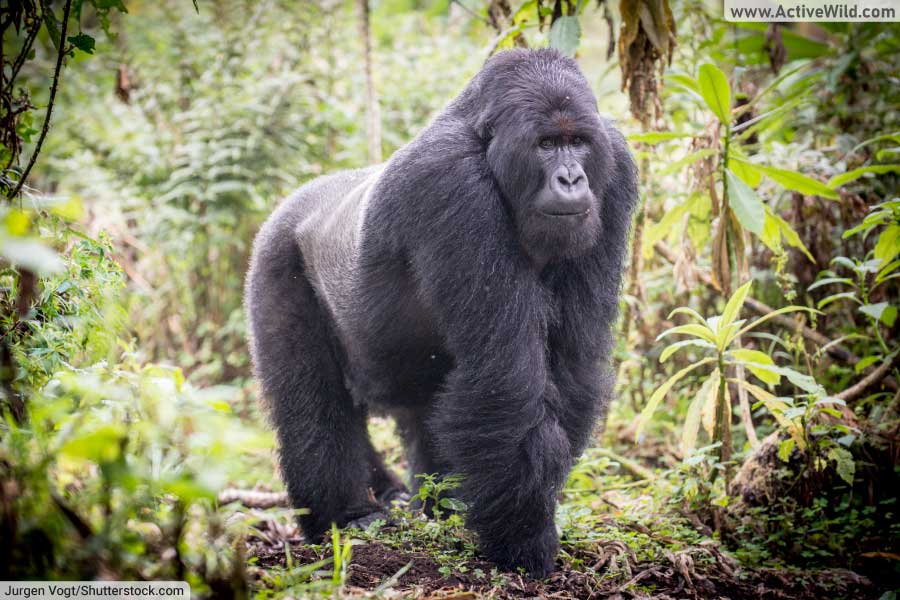
- Type Of Animal: Mammal
- Family: Hominidae
- Where Found: Africa
- Conservation Status: Critically Endangered
There are two species of gorilla, the eastern gorilla (Gorilla beringei) and the western gorilla (Gorilla gorilla). Both species are Critically Endangered.
Gorillas live in groups led by a large male known as a “silverback”. As with other primates, a group of gorillas is known as a “troop”. A gorilla troop also contains several females and their young. Larger troops may also contain young adult males known as “blackbacks”.
Gorillas are primates belonging to the family Hominidae, otherwise known as the “great ape” family. This family is also home to orangutans, chimpanzees and humans.
You can find out more about gorillas on this page: Gorilla Facts
You can see more critically endangered animals on this page: Critically Endangered Species List
Mandrill
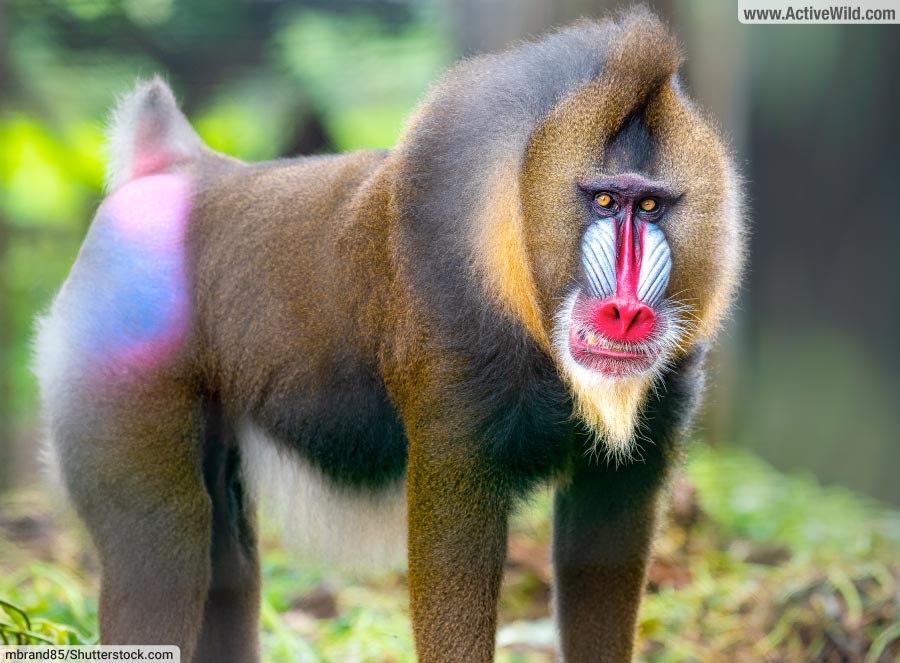
- Scientific Name: Mandrillus sphinx
- Type Of Animal: Mammal
- Family: Cercopithecidae
- Where Found: Africa
- Conservation Status: Vulnerable
The mandrill is the world’s largest species of monkey. It can weigh up to 54 kg (119 lb.), with a shoulder height of 65 cm (26 in.) while standing on all fours.
The species is highly distinctive, with a bright blue and red nose that is particularly prominent in the male.
The male mandrill is significantly larger than the female; the difference in size between the sexes is the largest of any primate. Male mandrills can weigh twice as much as females.
Mandrills inhabit the rainforests of the West African countries Cameroon, Republic of the Congo, Equatorial Guinea and Gabon. They live in large troops, spending most of the time on the ground, but also entering the forest canopy to feed.
You can find out more about the mandrill on this page: Mandrill Facts
You can see more monkeys on this page: Types of Monkeys with Pictures & Facts
Okapi
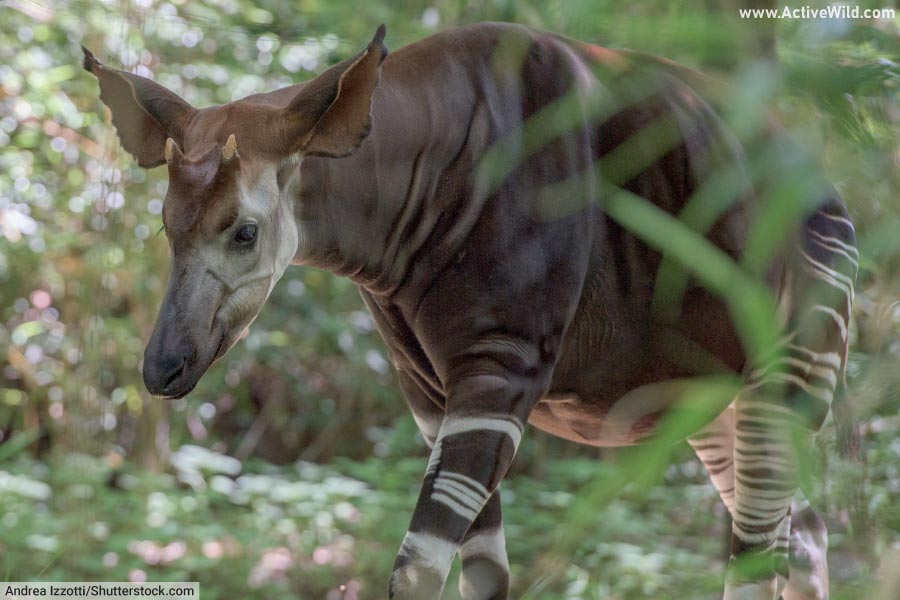
- Scientific Name: Okapia johnstoni
- Type Of Animal: Mammal
- Family: Giraffidae
- Where Found: Africa
- Conservation Status: Endangered
The okapi lives deep in the rainforests of Democratic Republic of the Congo in central Africa.
This forest animal is one of two species in the family Giraffidae. The other species in the family, and the okapi’s closest relation in the animal kingdom, is the much better-known giraffe.
The stripes on an okapi’s legs and hind quarters act as camouflage, helping to break up the okapi’s outline as it moves through the forest.
The okapi is an endangered animal. Its main threat is deforestation. The species is also hunted for its meat and skin.
You can find out more about the okapi on this page: Okapi Facts
Forest Animals Of Asia
Clouded Leopard

- Scientific Name: Neofelis nebulosa
- Type Of Animal: Mammal
- Family: Felidae
- Where Found: Asia
- Conservation Status: Vulnerable
The clouded leopard is a member of the subfamily Pantherinae, which is a subgroup of the cat family, Felidae.
This Asian animal gets its name from the cloud-like markings on its coat. These provide camouflage in the dense forest habitats in which the clouded leopard is found. It has a nose-tail length of around 1.65 m / 5.41 ft.
The clouded leopard is known as the “modern-day saber-tooth” due to the length of its canine teeth, which are longer, in proportion to skull size, than those of any other cat.
With short limbs, long tail, flexible ankles and strong, sharp claws, the clouded leopard is an expert climber. It can hang from branches and even climb down tree trunks head first.
You can find out more about the clouded leopard on this page: Clouded Leopard Facts
Great Hornbill

- Scientific Name: Buceros bicornis
- Type Of Animal: Bird
- Family: Bucerotidae
- Where Found: Asia
- Conservation Status: Vulnerable
The great hornbill is a member of the hornbill family, Bucerotidae. It has a wingspan of around 1.5m, making it one of the larger of the 59 recognized hornbill species.
The species is found in forests across Southeast Asia and the Indian subcontinent.
Sitting on top of the great hornbill’s huge, curved bill is a large casque (bony growth). Both bill and casque are orange-yellow in color. These features, together with the bird’s large size and yellow throat feathers, make the species one of the world’s most distinctive forest birds.
The great hornbill is primarily frugivorous (fruit-eating), but will occasionally supplement its diet with small vertebrates.
You can see more Asian animals on this page: Asian Animals
Orangutan

- Type Of Animal: Mammal
- Family: Hominidae
- Where Found: Asia
- Conservation Status: Critically Endangered
The three species of orangutan (Sumatran, Bornean and Tapanuli) live in forests on islands in Southeast Asia. All three are critically endangered and have populations that are decreasing.
The Sumatran orangutan (Pongo abelii) and Tapanuli orangutan (Pongo tapanuliensis) live in separate regions of the Indonesian island of Sumatra. The Bornean orangutan (Pongo pygmaeus) is found on the island of Borneo.
Orangutans belong to the great ape family, Hominidae, which is also home to gorillas, chimps, bonobos and humans.
The orangutans are the most arboreal (tree-dwelling) of the great apes. Their long arms and flexible shoulder and hip joints are adaptations for climbing and moving through the trees. Orangutans can grip with both their hands and their feet.
These distinctive red-haired primates are mainly fructivorous (fruit-eating), but supplement their diet with leaves, honey, insects and small vertebrates.
You can find out more about orangutans on this page: Orangutan Facts
Proboscis Monkey
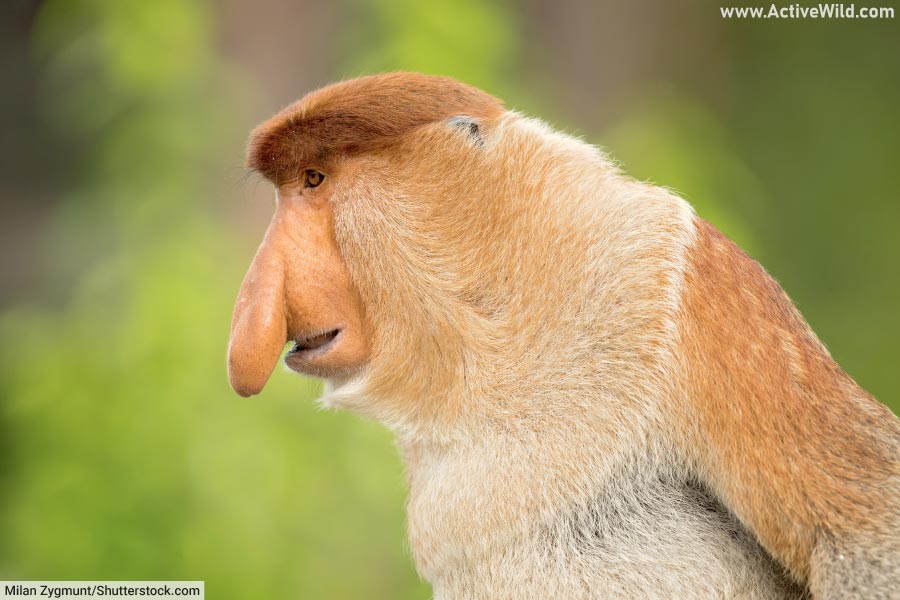
- Scientific Name: Nasalis larvatus
- Type Of Animal: Mammal
- Family: Cercopithecidae
- Where Found: Asia
- Conservation Status: Endangered
With its prominent nose, the proboscis monkey is one of the world’s best-known forest animals.
This distinctive primate is found only on the island of Borneo, and is one of Asia’s largest monkeys.
The proboscis monkey is strongly associated with water, and is usually found living near rivers or in mangrove forests (coastal forests that are waterlogged). It even has webbed toes for swimming – a skill that it uses to evade predators.
The long, fleshy nose of the male proboscis monkey serves to amplify its call, with females seemingly favoring males with louder calls.
The nose of the female, while somewhat larger than those of other monkeys, does not reach anywhere near the size of the male’s.
A highly vocal animal, the proboscis monkey will honk to warn its troop of predators, and shriek to express agitation or excitement.
You can find out more about the proboscis monkey on this page: Proboscis Monkey Facts
Discover more about monkeys on this page: Monkeys - The Ultimate Guide
Queen Alexandra's Birdwing Butterfly
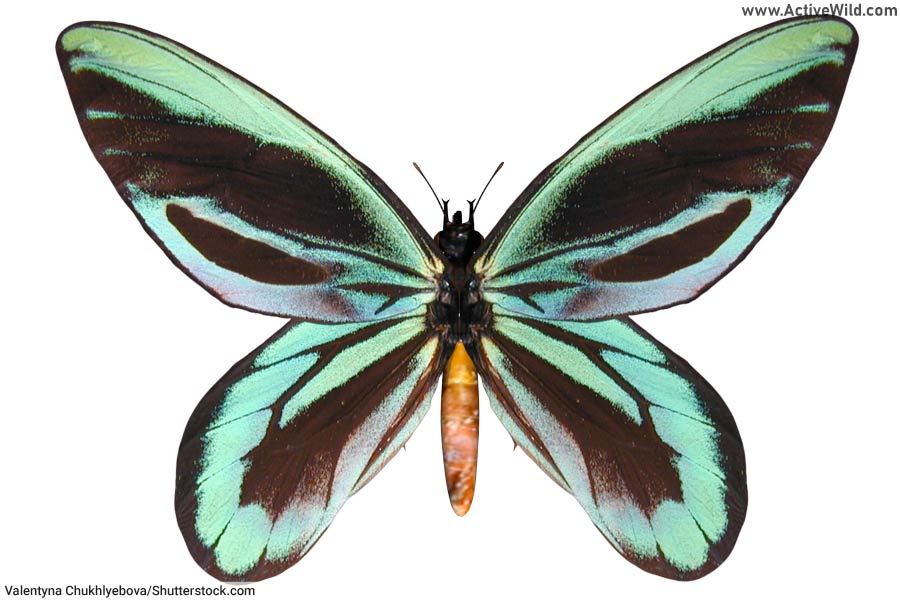
- Scientific Name: Ornithoptera alexandrae
- Type Of Animal: Insect
- Family: Papilionidae
- Where Found: Asia
- Conservation Status: Endangered
The Queen Alexandra’s birdwing butterfly is the world’s largest butterfly. The wingspan of the female (which is significantly larger than the male) can reach 25 cm / 9.84 in. and individuals can weigh up to 12 grams /0.42 oz. Females are brown and white, while the males are much more colorful, being iridescent green and black.
The Queen Alexandra’s birdwing is found only in a small region of Papua New Guinea.
The species’ endangered status is due to habitat loss. Much of the rainforest in which it lives has been destroyed to make way for palm oil plantations.
The eruption of Mount Lamington (a nearby volcano) also destroyed much of the insect’s natural habitat.
You can find out more about the Queen Alexandra’s birdwing butterfly on this page: Queen Alexandra’s Birdwing Butterfly Facts
Discover more about insects on this page: Insects – The Ultimate Guide
Sun Bear
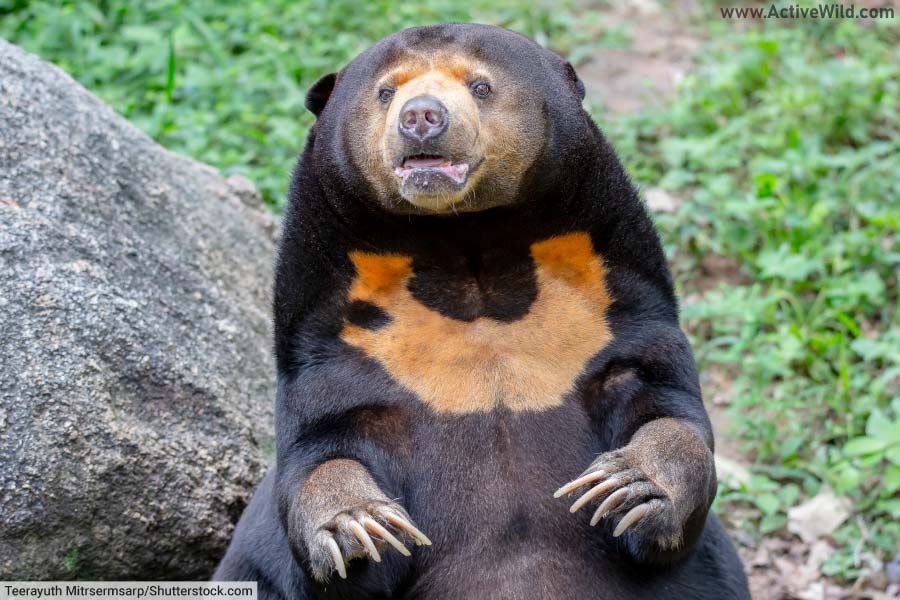
- Scientific Name: Helarctos malayanus
- Type Of Animal: Mammal
- Family: Ursidae
- Where Found: Asia
- Conservation Status: Vulnerable
The sun bear is the world’s smallest bear species, with a maximum shoulder height of around 28 in / 70cm, and weighing up to 145 lb. / 65 kg. It is usually black in color, although dark brown or reddish individuals are known.
The sun bear gets its name from its a distinctive pale, U-shaped chest patch, which resembles a setting sun.
The sun bear is found in Southeast Asia, both on the mainland, in countries such as India, Thailand, Myanmar, and Malaysia, and also on islands such as Borneo and Sumatra.
This forest-living bear is the most arboreal (tree-dwelling) of all bears.
Typically for a bear, the sun bear has an omnivorous diet, eating insects such as ants, termites and the larvae of beetles and bees and beetles, honey and fruit.
Long, powerful claws enable the sun bear to dig into the ground or break up wood in order to find food. Its tongue – the longest of any bear – helps it to gather food such as honey and grubs from trees.
You can find out more about the sun bear on this page: Sun Bear Facts
Tiger

- Scientific Name: Panthera tigris
- Type Of Animal: Mammal
- Family: Felidae
- Where Found: Asia
- Conservation Status: Endangered
The tiger is the world’s largest species of cat. With its distinctive orange coat and black stripes, it is one of the world’s most recognizable animals. The tiger is an apex predator (i.e., top of the food chain) wherever it is found. A tiger is capable of bringing down prey as large as a buffalo or gaur (Indian bison).
Biologists disagree over the number of tiger subspecies; recent research has identified just two subspecies: a mainland subspecies, and one found on the Greater Sunda Islands.
Other biologists believe that up to nine tiger subspecies exist, including well-known subspecies such as the Siberian Tiger and the Bengal Tiger.
Sadly, this fearsome predator is endangered. It is thought that there are now fewer than 4,000 tigers left in the wild.
You can find out more about the tiger on this page: Tiger Facts
Forest Animals Of Australia
Lumholtz's Tree-Kangaroo

- Scientific Name: Dendrolagus lumholtzi
- Type Of Animal: Mammal
- Family: Macropodidae
- Where Found: Australia
- Conservation Status: Near Threatened
Tree kangaroos are a group of kangaroos with adaptations for an arboreal (tree-dwelling) lifestyle, including a long tail, large feet and long arms. There are 13 species of tree kangaroo; together they make up the genus Dendrolagus.
Lumholtz’s tree-kangaroo is one of just two tree kangaroos found in Australia (the other being Bennett’s tree-kangaroo, Dendrolagus bennettianus).
The other tree kangaroos are found on New Guinea and neighboring islands.
Lumholtz’s tree-kangaroo is the smallest tree kangaroo, weighing 7 kg / 15.4 lb., with a body and tail length of 1.24 m / 4.1 ft. It is found in the rainforests of Queensland, Australia. The species is solitary outside of the mating season, and usually active at night.
You can see more marsupials on this page: Marsupials List with Pictures & Facts
Powerful Owl

- Scientific Name: Ninox strenua
- Type Of Animal: Bird
- Family: Strigidae
- Where Found: Australia
- Conservation Status: Least Concern
The powerful owl, also known as the “powerful boobook”, is the largest owl in Australia (the species is similar in size to the great grey owl of North America and Eurasia).
The species belongs to the “true owl” family, Strigidae, which is one of two owl families, the other being the “barn owl” family, Tytonidae.
An apex predator, the powerful owl is opportunistic and preys on a wide variety of animals, ranging from insects to other birds. Arboreal mammals, including animals such as possums, bats, gliders, and even koalas, form the bulk of its prey.
The powerful owl is found in forests in eastern Australia.
You can see more Australian animals on this page: Australian Animals List
Southern Cassowary

- Scientific Name: Casuarius casuarius
- Type Of Animal: Bird (Ratite)
- Family: Casuariidae
- Where Found: Australia
- Conservation Status: Least Concern
The southern cassowary is one of three species of cassowary, and the only one found in Australia. (The fourth member of the family Casuariidae is the emu, a large flightless bird found only in Australia.)
The cassowaries and emu belong to a group of flightless birds called ratites. This group also contains ostriches, kiwis and rheas.
The southern cassowary reaches a height of up to 1.8 m (5.9 ft) and is the world’s fourth-tallest bird, after the two species of ostrich and the emu.
The horn-like helmet on top of a cassowary’s head is called a casque. The exact function of the casque is unknown – it may be an indicator of a bird’s health to potential mates, or may serve to amplify the cassowary’s call.
The southern cassowary is found in forests in northeastern Australia and New Guinea.
You can find out more about cassowaries on this page: Cassowary Facts
Sugar Glider

- Scientific Name: Petaurus breviceps
- Type Of Animal: Mammal (Marsupial)
- Family: Petauridae
- Where Found: Australia
- Conservation Status: Least Concern
The sugar glider is a small possum that has evolved the ability to glide, doing so using wing-like membranes that stretch between its hands and feet on either side of the body.
Gliding through the forest, rather than climbing from tree to tree, uses less energy and is also a good way of evading predators.
The sugar glider can glide over distances of up to 50 m / 164 ft.
The sugar glider has a body and tail length of around 27 cm / 10.63 in. It is nocturnal and omnivorous. Its diet consists of sap / gum from trees, and insects.
You can find out more about the sugar glider on this page: Sugar Glider Facts
Tiger Quoll
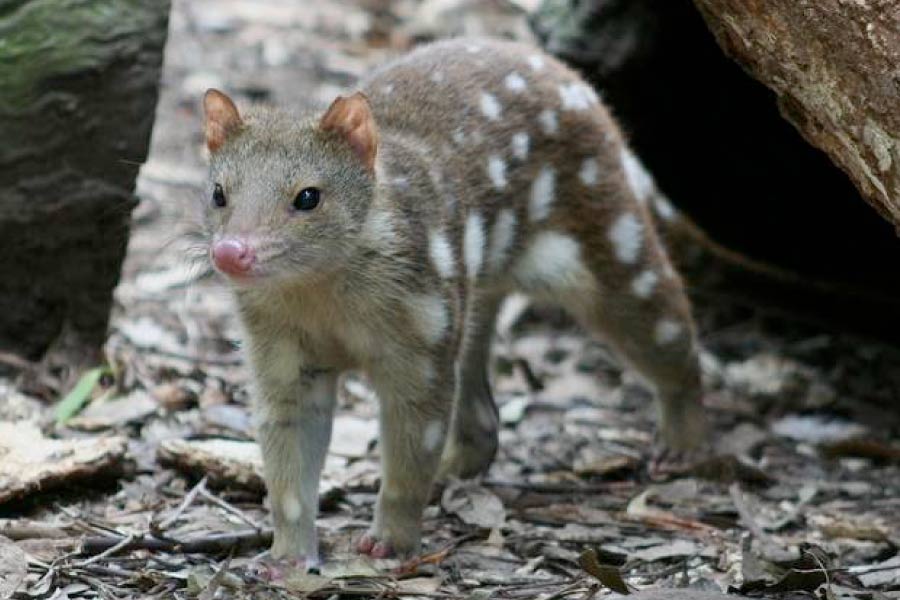
- Scientific Name: Dasyurus maculatus
- Type Of Animal: Mammal (Marsupial)
- Family: Dasyuridae
- Where Found: Australia
- Conservation Status: Near Threatened
The tiger quoll is one of six living species of quoll, and one of four found in Australia (the other two species are found in New Guinea).
Like the other quolls, the tiger quoll is a carnivorous, nocturnal marsupial. The tiger quoll is the largest of the quolls, and the second-largest carnivorous marsupial, after the Tasmanian devil. It is a similar weight to a wild rabbit such as the eastern cottontail or European rabbit.
The tiger quoll is found in forests in eastern mainland Australia and is also present on Tasmania. It is partially arboreal (tree-dwelling), and has ridged foot pads for climbing. The species preys on a variety of animals, hunting both on the ground and in the trees.
You can find out more about quolls on this page: Quoll Facts
Forest Animals Of Europe
Black Woodpecker

- Scientific Name: Dryocopus martius
- Type Of Animal: Bird
- Family: Picidae
- Where Found: Europe
- Conservation Status: Least Concern
Woodpeckers are a family, Picidae, of birds that live in forests and woodlands on all continents except for Australia and Antarctica.
Woodpeckers have a number of adaptations for living in forests. These include powerful bills, which are used both for drilling into trees and for drumming on tree trunks to communicate, and “zygodactyl” feet, which have two forward-facing and two rear-facing claws, an arrangement suitable for climbing up and down tree trunks.
The crow-sized black woodpecker is the largest woodpecker found in Europe and the second-largest in the world (the great slaty woodpecker is the world’s largest woodpecker). It is black apart from a red crest, which is longer in males.
The black woodpecker is found in forests across Eurasia, from Spain to Japan.
You can find out more about the different types of birds on this page: Types of Birds
Northern Goshawk
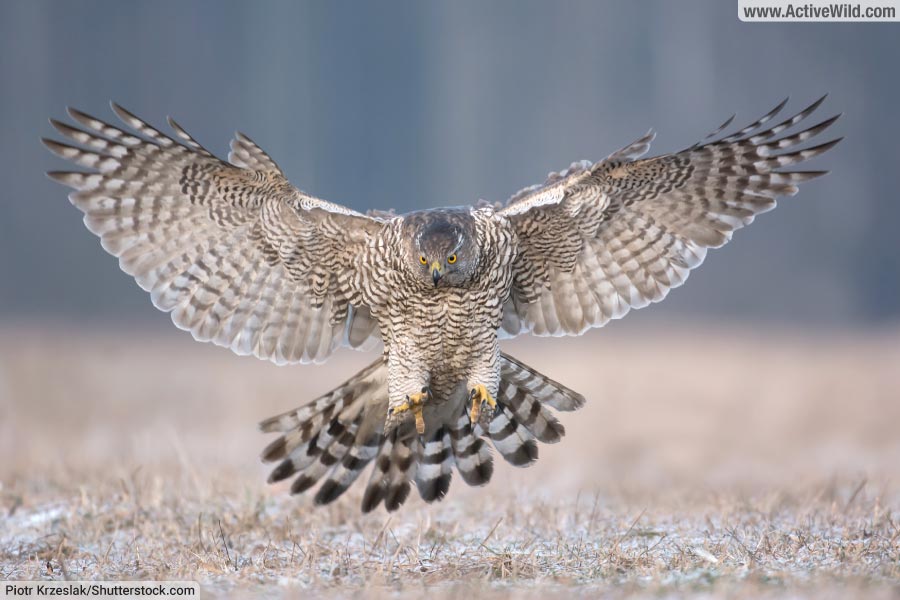
- Scientific Name: Accipiter gentilis
- Type Of Animal: Bird
- Family: Accipitridae
- Where Found: Europe, Asia, North America
- Conservation Status: Least Concern
The northern goshawk is a bird of prey found in forests across much of the Northern Hemisphere. This large hawk has a wingspan of up to 50 in. / 127 cm. As with most birds of prey, the female is larger than the male.
Like other birds of prey that live in forests and woodlands (such as the harpy eagle and sparrowhawk), the northern goshawk has relatively short, powerful wings for high-speed maneuvering between the trees.
Although the northern goshawk’s plumage varies depending on where it is found in its large range, most individuals are gray, with pale undersides and striped chests.
You can find out more about the different types of birds on this page: Types of Birds
Western Capercaillie

- Scientific Name: Tetrao urogallus
- Type Of Animal: Bird
- Family: Phasianidae
- Where Found: Europe
- Conservation Status: Least Concern
The western capercaillie, or simply capercaillie, is the largest member of the pheasant and grouse family, Phasianidae. Other birds in this family include pheasants, partridges, quail, peafowl, turkeys and chickens.
The male capercaillie weighs up to 7 kg / 15.43 lb., and is up to twice the size of the female. The difference in size between male and female capercaillie is one of the largest of all birds.
The capercaillie is found in conifer forests in Europe and Asia. During the breeding season, groups of male birds (cocks) perform a competitive territorial display, known as a “lek” to impress the watching females (hens).
You can find out more about the different types of birds on this page: Types of Birds
Wild Boar
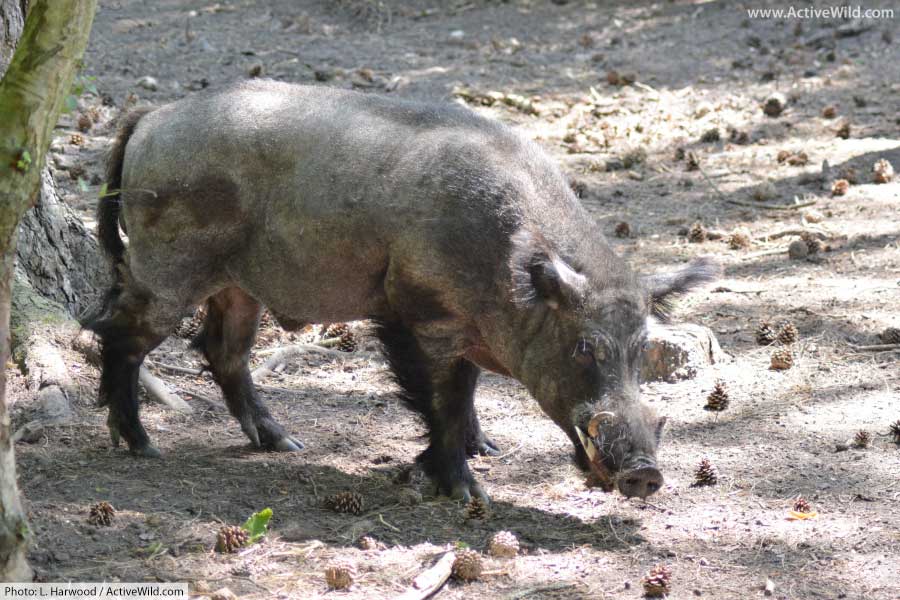
- Scientific Name: Sus scrofa
- Type Of Animal: Mammal
- Family: Suidae
- Where Found: Europe, Asia, Africa
- Conservation Status: Least Concern
The wild boar is a species of wild pig belonging to the pig family, Suidae. It is found across much of Europe and Asia, and its range extends southwards into northern Africa.
Primarily a forest animal, the wild boar is also found in habitats as varied as grasslands and semi-deserts, although it prefers habitats with some tree cover.
The boar’s large head makes up one-third its total body length, which can reach up to 1.5 m / 4.92 ft. Males are significantly larger and heavier than females. The canine teeth of the male protrude from the mouth, forming short tusks.
Male boars are typically solitary, while females live in small groups known as “sounders”.
Wolf
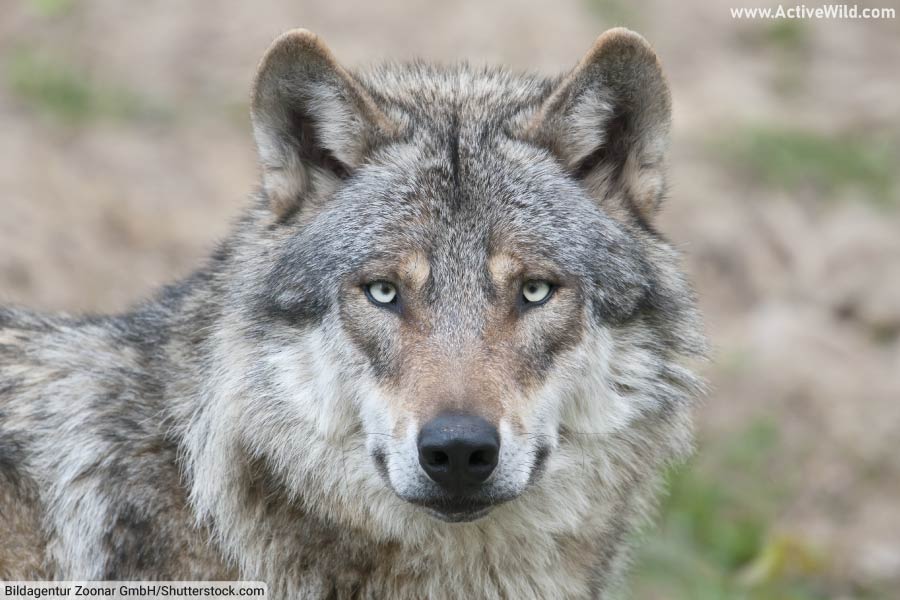
- Scientific Name: Canis lupus
- Type Of Animal: Mammal
- Family: Canidae
- Where Found: Europe, Asia, North America
- Conservation Status: Least Concern
The wolf is the largest member of the dog family, Canidae (although some domestic dog breeds are larger).
There are numerous wolf subspecies (37 subspecies are currently listed in the Mammal Species of the World database (source)
The most common wolf subspecies in Europe (and Asia) is the Eurasian wolf. This large subspecies is found across a wider range than any other wolf subspecies.
A carnivore, the wolf hunts both alone and in packs. It can run at speeds of 61.2 km / 38 miles an hour in short bursts while chasing prey. It is highly opportunistic and will feed on carrion when given the chance.
The wolf is a highly social animal and lives in “packs”, which usually comprise of a nuclear family. All members of the pack protect and care for the pups.
The wolf uses its acute sense of smell to locate prey. Most of the wolf’s diet is made up by large ungulates (hooved animals).
Wolves are adaptable animals that are found not only in forests, but also in a range of other habitats, including grasslands and wetlands.
You can find out more about wolves on this page: Wolf Facts
Forest Animals Of North America
American Black Bear
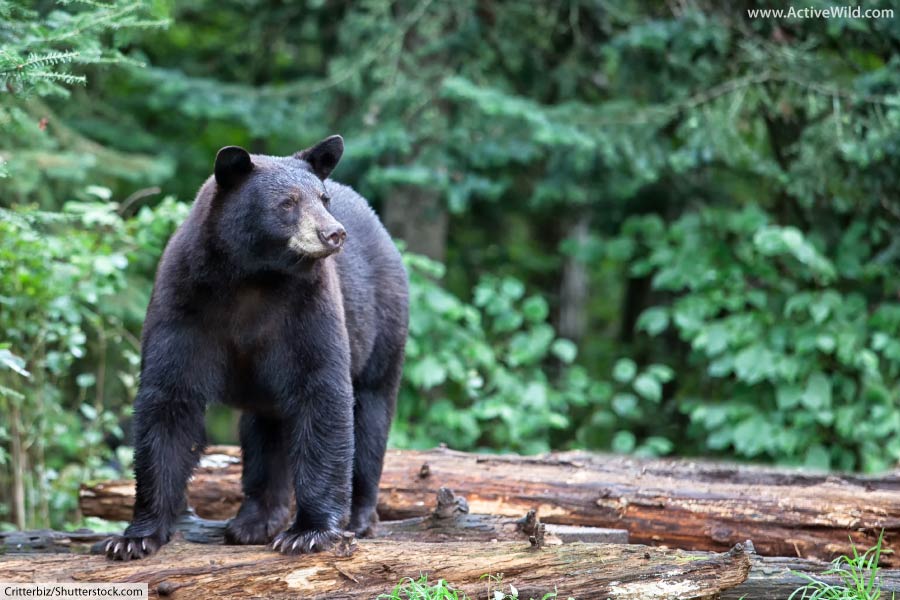
- Scientific Name: Ursus americanus
- Type Of Animal: Mammal
- Family: Ursidae
- Where Found: North America
- Conservation Status: Least Concern
The American black bear (known as the “black bear” in North America) is present in the majority of US and Canadian states, and both its population and range, unlike those of many other large forest animals, are increasing.
Although usually found in forests, the American black bear also lives in swamps, scrublands and tundra in some parts of its range.
A skilled climber, the American black bear has an arboreal (tree-dwelling) lifestyle, particularly when young. Its claws are shorter and sharper than those of the brown bear – this is an adaptation for climbing trees. Older black bears become more terrestrial (ground dwelling).
In the northernmost parts of its range, the black bear hibernates for up to 7 months of the year. In the southernmost regions of its range, it may not hibernate at all.
The black bear is an omnivore, but plants make up the majority (up to 85%) of its diet.
You can find out more about the American black bear on this page: American Black Bear Facts
Elk
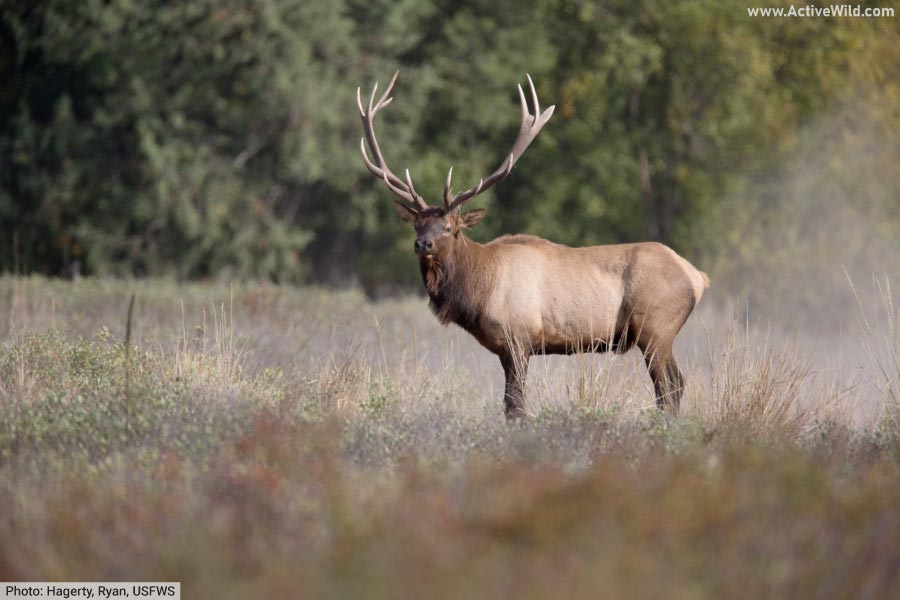
- Scientific Name: Cervus canadensis
- Type Of Animal: Mammal
- Family: Cervidae
- Where Found: North America, Asia
- Conservation Status: Least Concern
Weighing up to 1,100 lb. / 498.95 kg, the elk is the second-largest species of deer in the world (only the moose is larger). It is found in forest, shrubland and grassland habitats in North America and eastern Asia, often migrating to higher ground during the summer.
Confusingly, in Europe, the moose is known as an elk. Therefore, if you hear someone talking about the “European elk”, they’re actually referring to a moose.
During the mating season, bull elk fight one another, with the victor gaining mating rights over groups of females (these groups, which can contain 20 or more individuals, are known as “harems”). At this time, bull elks produce distinctive bugling cries.
The bull elk’s impressive antlers are shed after the mating season, only to begin growing again a few months later.
Today, the total elk population numbers around two million individuals, and is thought to be increasing. The species’ conservation rating is “Least Concern”.
Discover more amazing American animals on this page: North American Animals List with Pictures & Facts
Moose

- Scientific Name: Alces alces
- Type Of Animal: Mammal
- Family: Cervidae
- Where Found: North America, Europe, Asia
- Conservation Status: Least Concern
The moose is the largest member of the deer family, Cervidae. It can be identified by its large size, long nose and prominent lips. The male moose has large, “palmate” (resembling an open hand) antlers, which can be up to 1.5 m / 4.92 ft. across.
The moose is found in both boreal and temperate forests across much of the northern hemisphere. It is a solitary animal, only seeking others during the mating season, when male moose fight for mating rights to females.
Although herbivores, moose can behave aggressively towards humans.
You can find out more about the moose on this page: Moose Facts
North American Porcupine
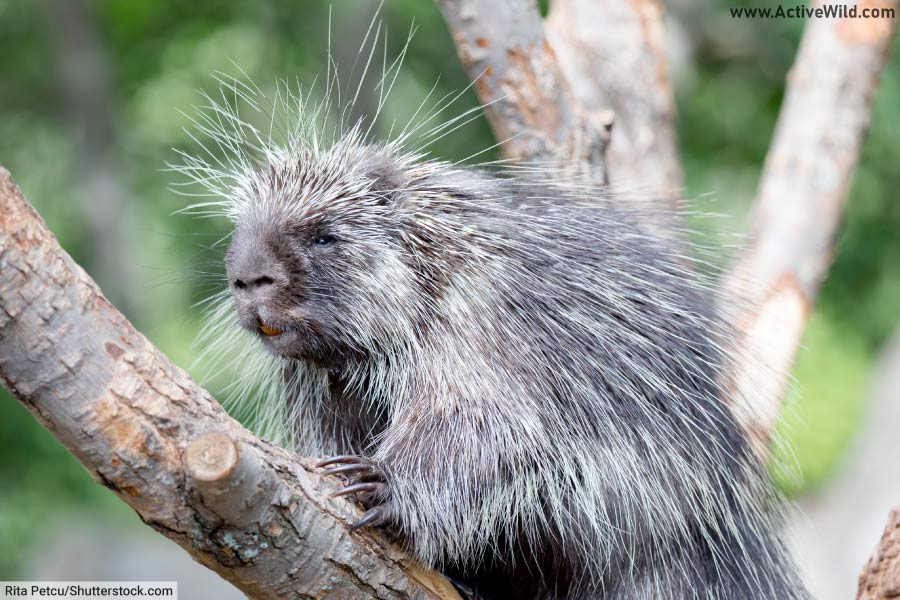
- Scientific Name: Erethizon dorsatum
- Type Of Animal: Mammal
- Family: Erethizontidae
- Where Found: North America
- Conservation Status: Least Concern
The North American porcupine is the second-largest rodent found in North America (the largest is the North American beaver). It is a slow-moving mammal that spends much of its life in the trees. It is mostly nocturnal.
Like all porcupines, the North American porcupine has a coat of sharp quills. The quills, which are actually modified hairs, serve as a defense against predators.
The North American porcupine belongs to the New World porcupine family, Erethizontidae.
Despite the New World and Old World (Hystricidae) porcupine families having similar adaptations, they are not closely related.
You can find out more about the North American porcupine on this page: North American Porcupine Facts
Pileated Woodpecker

- Scientific Name: Dryocopus pileatus
- Type Of Animal: Bird
- Family: Picidae
- Where Found: North America
- Conservation Status: Least Concern
The pileated woodpecker is a member of the woodpecker family, Picidae, found in forests in the United States and Canada. The plumage of this almost crow-sized bird is mainly black, with a white stripe either side of the face and neck, and a prominent red cap.
Slightly smaller than the black woodpecker of Eurasia, the pileated woodpecker is the world’s third-largest woodpecker (the largest is the great slaty woodpecker, found in Asia).
The pileated woodpecker makes large, rectangular holes in tree trunks as it searches for insects. Its main prey is carpenter ants, but this omnivorous bird also eats a variety of other insects and their larvae, as well as fruits, berries and nuts.
You can find out more about the different types of birds on this page: Types of Birds
Raccoon

- Scientific Name: Procyon lotor
- Type Of Animal: Mammal
- Family: Procyonidae
- Where Found: North America
- Conservation Status: Least Concern
The raccoon is a mid-sized mammal that is widespread throughout much of North America. Its distinctive black and white coloration has made this intelligent mammal one of the most familiar American species.
The raccoon belongs to the carnivoran family Procyonidae, which is also home to animals such as coatis and ringtails.
The raccoon was originally a forest animal, but this adaptable species is today found in a wide variety of additional habitats, including urban environments.
This nocturnal animal is an omnivore whose varied diet includes eggs, insects, small vertebrates and the discarded remains of human food.
You can find out more about the raccoon on this page: Raccoon Facts
Forest Animals Of South America
Black Howler Monkey
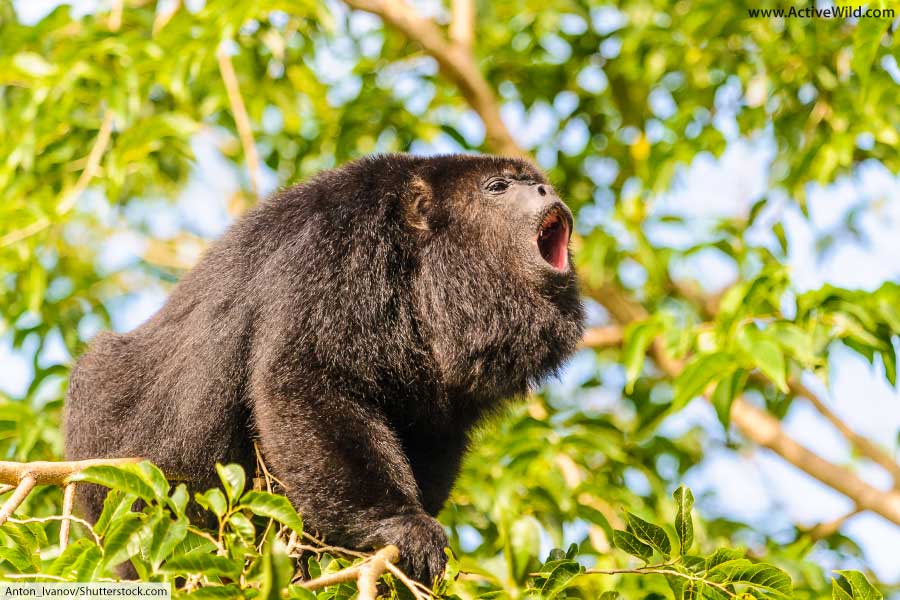
- Scientific Name: Alouatta caraya
- Type Of Animal: Mammal (Primate)
- Family: Atelidae
- Where Found: South America
- Conservation Status: Near Threatened
The black howler monkey is one of ten species of howler monkey (source https://www.departments.bucknell.edu/biology/resources/msw3/browse.asp?s=y&id=12100374) (some authorities have recognize more species), which together make up the genus Alouatta. Alouatta is part of the family Atelidae, which is also home to spider monkeys, woolly monkeys, and woolly spider monkeys, all of which are found in the forests of Central and South America.
Despite its name, only the male black howler monkey is black; the female is blonde. Like all monkeys of family Atelidae, the black howler monkey has a prehensile tail, which can be used to grip onto branches for support.
Howler monkeys are less reliant on their tails than other atelids, and usually walk on all fours along the tops of branches.
The black howler monkey, like other howler monkeys, is known for its loud howl, which can be heard over 2 km / 1.24 miles away.
Howler monkeys howl to alert other troops of their location. Using howls to mark out territory prevents rival troops from fighting.
You can find out more about howler monkeys on this page: Howler Monkey Facts
Brown-Throated Sloth
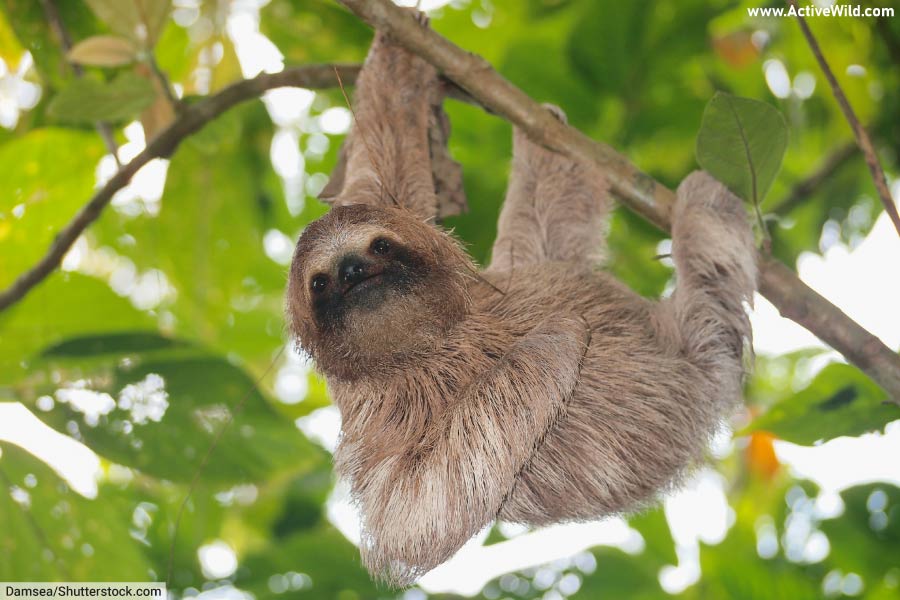
- Scientific Name: Bradypus variegatus
- Type Of Animal: Mammal
- Family: Bradypodidae
- Where Found: South America, Central America
- Conservation Status: Least Concern
Sloths are a group of arboreal animals found in the forests of Central and South America. These animals are known for their habit of hanging upside-down from branches and slow movement.
Four of the six living sloth species are “three-toad sloths” of family Bradypodidae and genus Bradypus; the remaining two species are “two-toad sloths” of family Choloepodidae and genus Choloepus.
Three-toed sloths have three toes on their forelimbs, while two-toed sloths have two toes on their forelimbs. (All sloths have three toes on their hind limbs.)
The brown-throated sloth is the most common of the six living sloths. It is a three-toed sloth found in Central and South America. The species sleeps between 15 and 18 hours a day and only descends from the forest canopy around once a week in order to defecate.
You can find out more about sloths on this page: Sloth Facts
Harpy Eagle
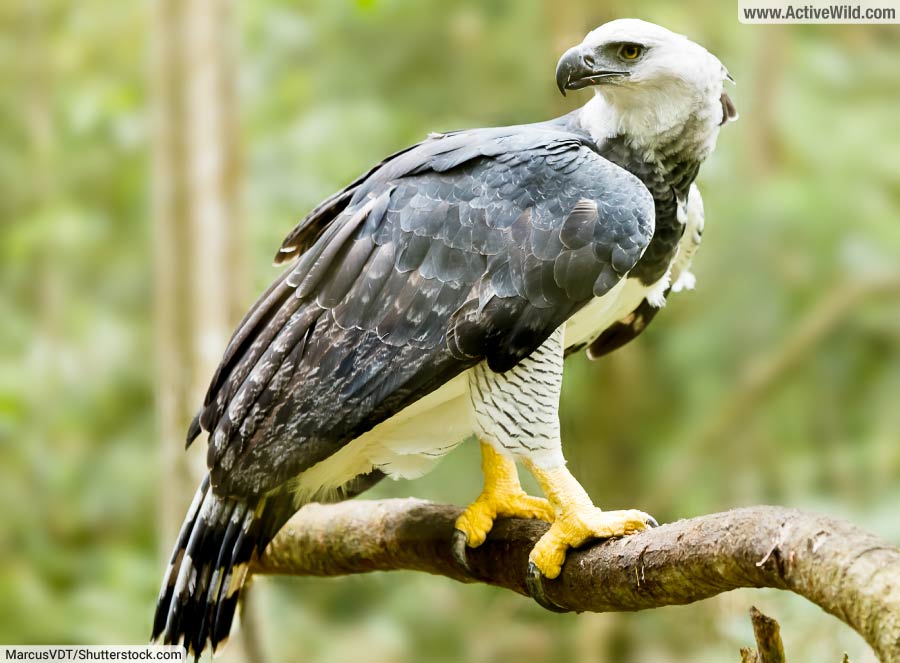
- Scientific Name: Harpia harpyja
- Type Of Animal: Bird
- Family: Accipitridae
- Where Found: South America
- Conservation Status: Near Threatened
The harpy eagle is a large, powerful eagle found in forests in Central and South America.
Although the wingspan of a harpy eagle can exceed 2 meters (6.5 ft), those of several similarly-sized eagles are even larger. It’s thought that the harpy eagle’s (relatively) small wingspan helps it to hunt in a forest habitat.
The harpy eagle has the largest talons of any eagle, and is capable of plucking animals such as monkeys or sloths out of the trees. This powerful bird is able to lift weights of up to 7 kg (15.4 lb.)
The harpy eagle is an apex predator in its forest ecosystem.
You can find out more about the harpy eagle on this page: Harpy Eagle Facts
Keel-Billed Toucan
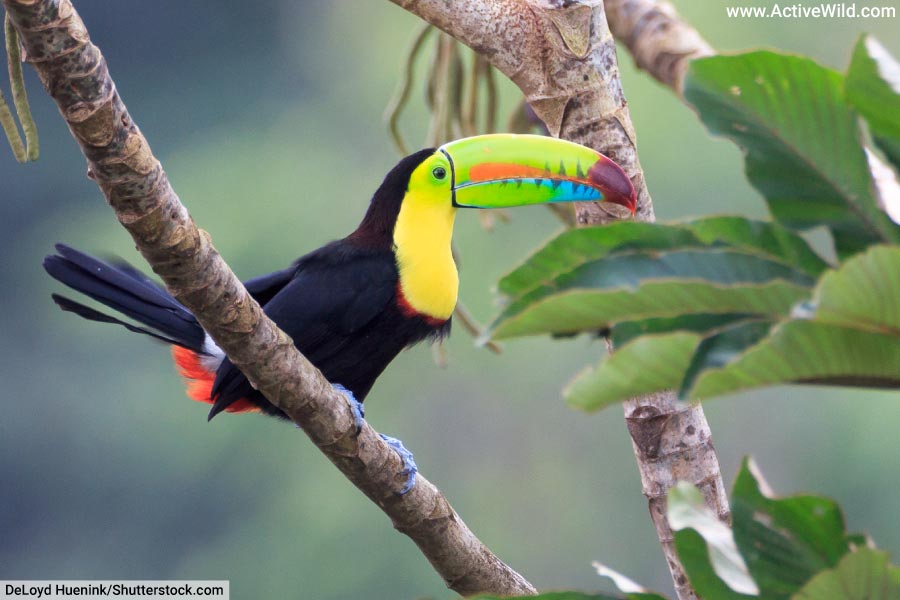
- Scientific Name: Ramphastos sulfuratus
- Type Of Animal: Bird
- Family: Ramphastidae
- Where Found: South America
- Conservation Status: Near Threatened
The keel-billed toucan is found in forests in Central and South America. Its colorful bill is up to 15 cm / 5.91 in. in length, and makes up around one third of the bird’s total body length.
A toucan’s bill is a lightweight structure. Rather than being a weapon, its primary use may be to control the bird’s temperature. The toucan also uses its bill to reach food without having to change position in the tree, thereby saving energy
Like woodpeckers, toucans have zygodactyl feet, which means that the outer pair of their four toes points backwards, while the inner pair point forwards. This is an adaptation for climbing trees.
You can find out more about toucans on this page: Toucan Facts
South American Tapir
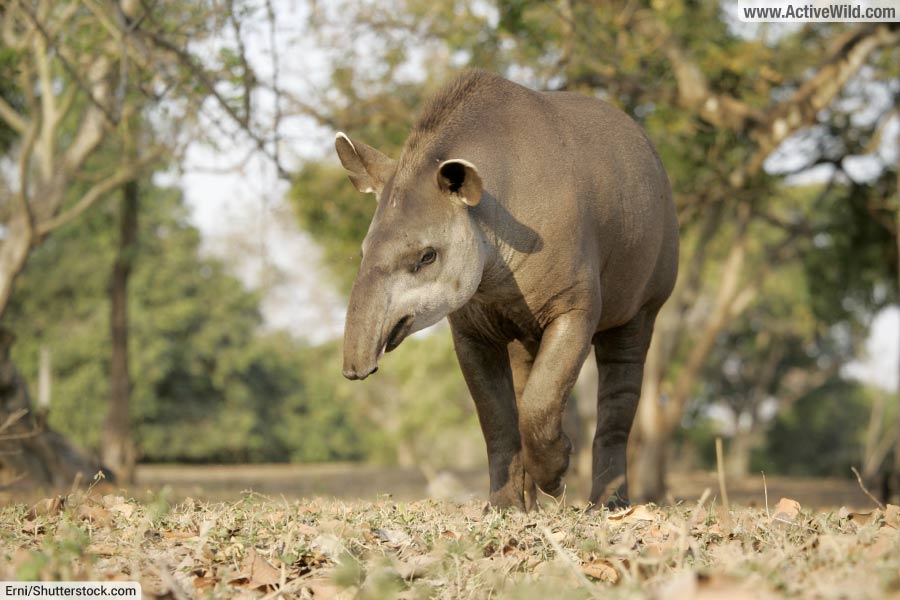
- Scientific Name: Tapirus terrestris
- Type Of Animal: Mammal
- Family: Tapiridae
- Where Found: South America
- Conservation Status: Vulnerable
The South American tapir is one of four tapir species, the others being the mountain tapir and Baird’s tapir, which are also found in the Americas, and the Malayan tapir, which is found in Southeast Asia.
The South American tapir, which is also known as the lowland tapir and the Brazilian tapir, is the only tapir found in the Amazon rainforest, where it is the largest land mammal. It typically grows to around 2.15 m / 7.05 ft. in length, and weighs around 225 kg / 496.04 lb.
Like all tapirs, the South American tapir has a prehensile nose. Using this “mini trunk”, the tapir is able to grasp and manipulate food and other objects.
The main threats to the South American tapir, which has the conservation status “Vulnerable”, are deforestation and hunting.
You can find out more about tapirs on this page: Tapir Facts


